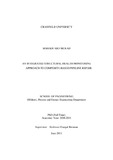JavaScript is disabled for your browser. Some features of this site may not work without it.
| dc.contributor.advisor | Brennan, Feargal | |
| dc.contributor.author | Abd Murad, Mahadi | |
| dc.date.accessioned | 2012-05-11T13:28:50Z | |
| dc.date.available | 2012-05-11T13:28:50Z | |
| dc.date.issued | 2011-06 | |
| dc.identifier.uri | http://dspace.lib.cranfield.ac.uk/handle/1826/7138 | |
| dc.description.abstract | One of the most common problems in the structural integrity of industrial pipelines is external corrosion. Composite materials have been accepted as a repair option to restore the original strength of the effected damaged section but the approach to analyse how well the composite repair has influenced the stress and strain distributions between the reinforced steel and the reinforcing composite is yet to be determined. This approach is required since it can increase the confidence level among pipeline operators or manufacturers in terms of the composite repair solution that they have chosen or offered. The aim of this study was to develop an integrated approach that could provide a complete methodology to assess the integrity of pipeline systems, especially in quantifying the level of reinforcement provided by the repair in the elastic working region. This cannot be achieved by the traditional method that only relies on classical mechanics derived from strength of materials and compatibility relations. To fulfil this aim, efforts included the simulation of a fibre glass composite repair system using finite element analysis (ABAQUS) software, design and fabrication of the pressure and temperature test rig, installation of fibre glass composite material, and data acquisition. The arc-shaped notch defect that has never been studied before was chosen in the study of stress concentration and bonding integrity of the composite repair system and further validated experimentally using the test rig. The numerical results of this work demonstrated different stress concentration values as the arc-shaped defect size increased. With a proper test plan, the optimum repair system that contains variable lengths of the arc-shaped defect and different lengths as well as thicknesses of the composite material was achieved in the stress distribution study. The bonding integrity via strain distribution study was further validated experimentally. The experimental pressure test results showed some good agreement, especially in the hoop load transfer and limitations of the simulation works were adequately addressed. The experimental temperature results managed to show how the thermal strain behaved in the anisotropic Triaxial Woven Fibre composite repair system. This approach is useful for a better acquisition of information that enables the diagnosis and prognosis of the pipeline repair system prior to installation on site. The novelty of this technique is in its ability to analyse the load transfer in a composite repair system in a more efficient way which can save time and cost. | en_UK |
| dc.language.iso | en | en_UK |
| dc.publisher | Cranfield University | en_UK |
| dc.rights | © Cranfield University 2011. All rights reserved. No part of this publication may be reproduced without the written permission of the copyright owner. | en_UK |
| dc.title | An integrated structural health monitoring approach to composite-based pipeline repair | en_UK |
| dc.type | Thesis or dissertation | en_UK |
| dc.type.qualificationlevel | Doctoral | en_UK |
| dc.type.qualificationname | PhD | en_UK |
